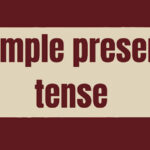- I eat breakfast every morning.
- She works in a bank.
- The sun rises in the east.
- They play soccer on weekends.
- The Earth revolves around the sun.
In these examples,
the verbs “eat,” “works,” “rises,” “play,” and “revolves” are in the simple present tense.
The tense indicates that the actions or situations expressed are habitual, ongoing, or generally true.
formula or structure
The formula or structure for the present simple tense in English is as follows:
Positive:
Subject + Base Form of the Verb + (s/es) + Object/Complement
Negative:
Subject + Do/Does + Not + Base Form of the Verb + Object/Complement
Question:
(Do/Does) + Subject + Base Form of the Verb + Object/Complement
Here are some examples to illustrate the formula:
Positive:
- I eat an apple.
- She plays the piano.
- We go to the park.
- They speak English.
Negative:
- I do not eat meat.
- She does not watch TV.
- We do not like spicy food.
- They do not live in that city.
Interrogative:
- Do you like chocolate?
- Does she work on weekends?
- Do we have a meeting tomorrow?
- Do they play basketball?
In the positive form, the subject is followed by the base form of the verb.
In the third-person singular (he/she/it),
an ‘s’ or ‘es’ is added to the verb.
In the negative form, the auxiliary verb ‘do/does’ is used, followed by ‘not’ and the base form of the verb.
In questions, the auxiliary verb ‘do/does’ comes before the subject, and the base form of the verb follows it.
Rules for using the present simple tense in English:
Here are the rules for using the present simple tense in English:
General or habitual actions:
The present simple tense is used to express actions that are general, habitual, or repeated.
For example:
I drink coffee every morning.
She always arrives on time.
Permanent situations or states:
The present simple tense is used to describe permanent situations or states that are true in general.
For example:
The sun rises in the east.
Water boils at 100 degrees Celsius.
Facts and general truths:
The present simple tense is used to state facts or general truths.
For example:
The Earth revolves around the sun.
Dogs are loyal animals.
Scheduled events:
The present simple tense is used to express future events that are part of a fixed schedule or timetable.
For example:
The train leaves at 9:00 a.m. tomorrow.
The concert starts in an hour.
Verb forms in the present simple tense:
For most verbs, the base form of the verb is used: I work, you play, they study.
In the third-person singular (he/she/it), ‘s’ or ‘es’ is added to the base form of the verb:
He works, she plays, it runs.
Negative form and question form:
Negative form:
The auxiliary verb ‘do/does’ is used before the subject, followed by ‘not’ and the base form of the verb:
I do not like coffee.
She does not speak French.
Question form:
The auxiliary verb ‘do/does’ is used before the subject, and the base form of the verb follows it:
Do you play the guitar?
Does she have a car?
How to explain simple present tense to students
When explaining the present simple tense to students, it’s helpful to break it down into its basic usage and structure. Here’s a simplified explanation you can use:
Introduce the concept:
Start by explaining that the present simple tense is used to talk about actions, situations, or facts that are general, habitual, or true in general. It is not specific to the present moment, but rather refers to things that happen regularly or are always true.
Formulation:
Explain that the present simple tense is formed by using the base form of the verb (infinitive) without any inflection or conjugation, except for the third-person singular where ‘s’ or ‘es’ is added to the verb.
Subject-verb agreement:
Highlight that the verb form changes in the third-person singular (he/she/it) by adding ‘s’ or ‘es’ to the base form. Emphasize this distinction.
Provide examples:
Give simple and relatable examples to illustrate the concept.
For instance:
“I eat breakfast every day.”
“She likes to read books.”
“The bus arrives at 8 a.m.”
Usage:
Explain different situations where the present simple tense is used, such as routines, habits, general truths, and permanent situations. Give examples for each category.
Negative and interrogative forms:
Briefly introduce the negative and interrogative forms of the present simple tense, explaining that ‘do’ or ‘does’ is used to form questions and negative statements.
Practice exercises:
Engage students in exercises where they can practice using the present simple tense. Provide sentences with gaps for them to fill in the correct verb forms, both positive and negative. Review and discuss the answers as a class.
Use visuals and real-life examples:
Incorporate visual aids, such as timelines or daily routines, to help students visualize the concept and reinforce their understanding. Provide real-life examples to make the usage more relatable.
Encourage practice:
Encourage students to use the present simple tense in their own sentences and conversations. Assign homework or in-class activities where they can practice using the tense accurately.
Review and reinforce:
Regularly review the present simple tense with students, providing additional exercises or activities to reinforce their understanding. Offer opportunities for them to ask questions and seek clarification.
By following these steps, you can help students grasp the concept of the present simple tense and confidently use it in their communication.
Exercise: Present Simple Tense
Instructions: Fill in the blanks with the appropriate form of the verb in the present simple tense.
My sister __________ (play/plays) the piano.
We __________ (live/lives) in a big house.
They __________ (study/studies) English at school.
He __________ (go/goes) to the gym every day.
The sun __________ (rise/rises) in the morning.
Cats __________ (like/likes) to chase mice.
We __________ (watch/watches) movies on weekends.
She __________ (work/works) as a nurse.
The
store __________ (open/opens) at 9 a.m.
They __________ (not like/doesn’t like) spicy food.
Answers:
plays
live
study
goes
rises
like
watch
works
opens
don’t like
Learn more Tenses





9 thoughts on “Simple Present Tense”